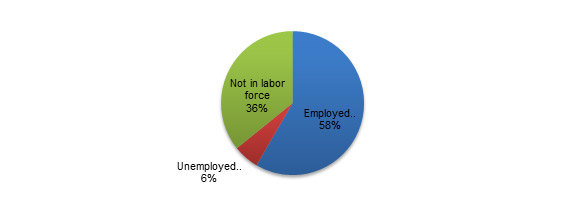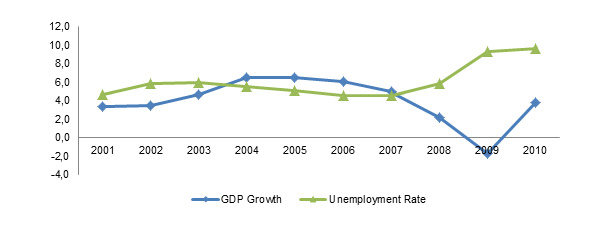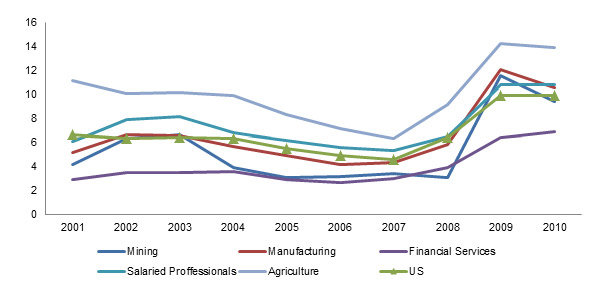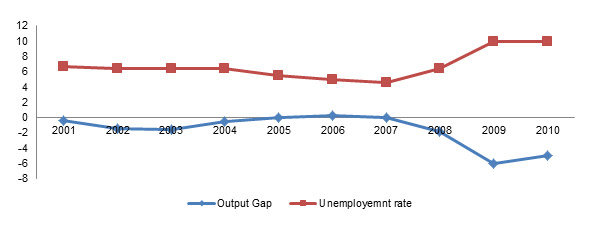Unemployment rate provides the percentage of the population above the age of 16 years that is not engaged in any form of employment. According to the US Bureau of Labor Statistics, March 2011 data, unemployment rate in the US was 8.8 percent (BLS). The present labor force in the US is divided into people who are above 16 years of age and are employed that constitute 58 percent of the labor force, 6 percent are unemployed, and 36 percent were not in labor force, who constitute those who have started looking for a job.

Figure 1: US Employment situation in January 2011, Source: Bureau of Labor Statistics
The unemployment rate in the country has been undergoing a seasonal change from 2005 through mid 2008. The unemployment rate every month recorded by the Bureau of Labor Statistics had shown similar trend in the change in rate and the rate was more or less stable. However, from mid of 2008, the unemployment rate started to increase. This is apparent from figure 1 where there is a distinct increase in the unemployment rate from middle of 2008 through 2010.

Figure 2: Unemployment rate (seasonally adjusted), Source: U.S. Bureau of Labor Statistics
The rise in the unemployment rate in 2008 can be termed as cyclical unemployment rate, i.e. the unemployment that occurs due to changes in business cycle.
If the unemployment rate and the GDP growth of the US are compared for a decade, it is observed that there is a distinct negative relation between GDP growth and unemployment rate. Figure 3 shows as the economic condition worsened with declining GDP growth from 2005, there was a gradual increase in unemployment rate. A decline in GDP growth indicates decline in production in all sectors.
Therefore, as the production weakens, there is a decline in demand for labor that eventually leads to less employment and greater unemployment in the economy. There was a sharp increase in unemployment rate as the GDP growth declined in 2007. Thus, the unemployment rate in the US had increased considerably since 2008, due to weakening of the GDP.

Figure 3: Unemployment rate and GDP Growth compared, Source: Bureau of Labor Statistics and Bureau of Economic Analysis (BEA)
An analysis of the unemployment rate in different industries shows that the annual average unemployment rate for the different industries as compared to the US national average for each year (see figure 4). The data demonstrates that unemployment rate in the agriculture and salaried professionals the unemployment rate has been higher than that of the US national average.
However, that of manufacturing sector, mining, and financial services sector, the rate has been lower. Nevertheless, the scenario changed for manufacturing sector in post-2008 era, as due to the financial crisis, there was higher unemployment rate. In all the sectors, the unemployment rate had been affected due to the decline in the GDP growth.

Figure 4: Unemployment rate by Industry, Source: Bureau of Labour Statistics
Difference in the unemployment rate due to the change in age demographics of the workforce is a serious consideration in an economy. As in case of the US, the highest unemployment rate is observed for younger workforce i.e. within the age group of 16 to 19 years and least for the highest age group of above 55 years. Though the overall unemployment rate in each age group followed the similar pattern of rise and fall through time.

Figure 5: Unemployment rate by Age, Source: Bureau of Labor Statistics
The unemployment rate for part-time workers is lower and relatively more stable than that of the full-tile workers, as there is a greater chance of increase in unemployment rate of full time workers due to the changes in business cycles. As is observed during the economic recession since 2007, with decline in GDP growth rate, the decline in the rate of unemployment was much higher for full-time workers than that of part-time workers.

Figure 6: Unemployment rate by nature of employment, source: Bureau of Labor Statistics
An interesting feature observed in the US economy is the effect of output gap on unemployment. It is observed that the output gap (Economy Watch) decreases with increase in unemployment. This is a paradoxical finding, as these should be positively related.

Figure 7: Comparison between unemployment rate and Output Gap, Source: BLS and Economy Watch
What are the consequences of an increase in unemployment rate in the US economy? The other effects of unemployment are that it would directly affect the income of individuals, as individual income will fall with less employment available to the people.
With decline in full time employment, the situation would worsen. Less income would imply that people would have less disposable income at hand to spend, therefore, decreasing their demand for consumable goods. This would decrease the overall demand in the economy. This would increase excess supply, as there would be higher amount of supply of goods in the economy, with less demand.
The excess supply created for goods would force industries to decline production, in order to reduce their inventory level. This consequently would lead to lower production in the economy. Therefore, the increase in unemployment rate in the US can be related to the lower demand of goods in the US market during the recession, as people had less money at hand to spend on durable or non-durable goods. This led to the reduction in production in the economy.
Works Cited
BEA. Bureau of Economic Analysis. 2011. Web. <https://www.bea.gov/>.
BLS. “Unemployment.” 2011. U.S. Bureau of Labour Statistics. Web. <https://www.bls.gov/data/#unemployment>.
Economy Watch. United States Output Gap . Web. <http://www.economywatch.com/economic-statistics/United-States/Output_Gap_Percent_of_Potential_GDP/>.